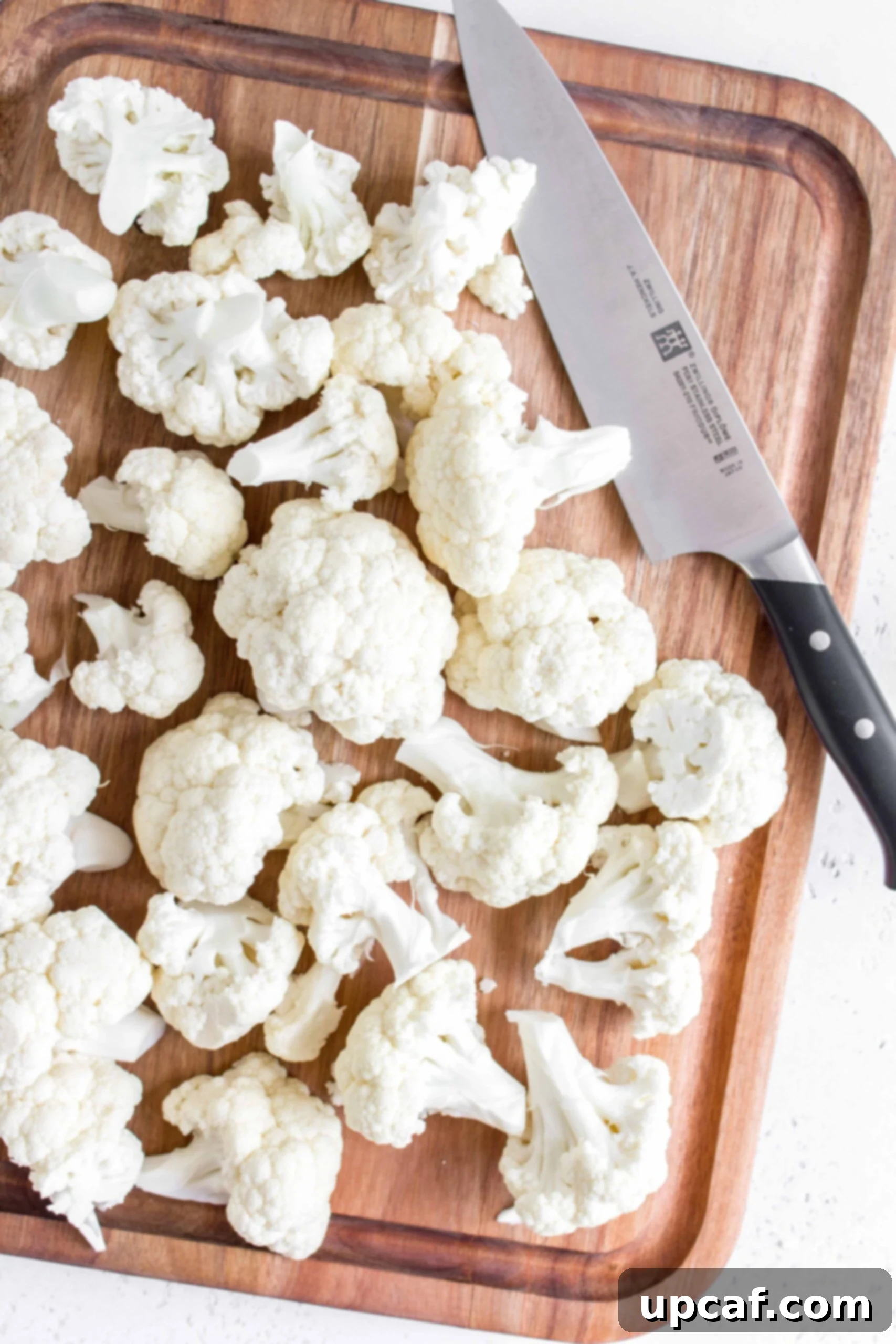Unlock the secret to perfectly portioned, fresh cauliflower florets while saving money by doing it yourself! This comprehensive guide will walk you through the easiest and most efficient method for cutting cauliflower, ensuring minimal mess and maximum yield. Beyond just the cut, we’ll delve into selecting the best head, smart storage solutions, freezing techniques, and creative ways to incorporate this versatile vegetable into your diet. Get ready to transform a humble head of cauliflower into culinary gold!

How to Pick the Best Cauliflower
Before you even think about slicing, the journey to perfect cauliflower florets begins at the grocery store. Selecting a high-quality head of cauliflower is crucial for both taste and texture. Here’s a detailed guide on what to look for to ensure you’re bringing home the freshest and finest:
- Color is Key: Aim for cauliflower that boasts a bright white or creamy white color uniformly throughout. Any significant yellowish or brownish discoloration can indicate that the cauliflower is past its prime or has been exposed to too much sunlight. While minor spots might be trim-able, widespread discoloration suggests a loss of freshness and potential bitterness.
- Inspect for Spots: Actively avoid heads with brown, wet, or moldy spots. These are clear indicators of spoilage and can quickly spread, compromising the entire head. Soft spots or areas that feel mushy are also red flags and should be avoided. A truly fresh cauliflower will be pristine.
- Firmness and Density: Gently squeeze the head of the cauliflower. It should feel notably firm and dense, not hollow or spongy. A firm head means it’s packed with moisture and nutrients, offering a crisp texture when cooked. A soft cauliflower often indicates dehydration or age.
- Check the Leaves and Stem: Don’t overlook the outer leaves and stem! They are excellent indicators of freshness. Look for vibrant, green, crisp leaves tightly wrapped around the base of the head. Wilted, yellowed, or sparse leaves signal that the cauliflower has been sitting around for a while. The stem itself should also appear firm and light green, free from cracks or dryness.
- Weight Matters: A fresh head of cauliflower will feel heavy for its size. This density is a good sign of high water content and overall freshness.
By following these simple tips, you’ll consistently pick the best cauliflower, setting the stage for delicious meals and ensuring your efforts in cutting it are worthwhile. Investing a few extra moments at the produce aisle pays off significantly in flavor and quality.
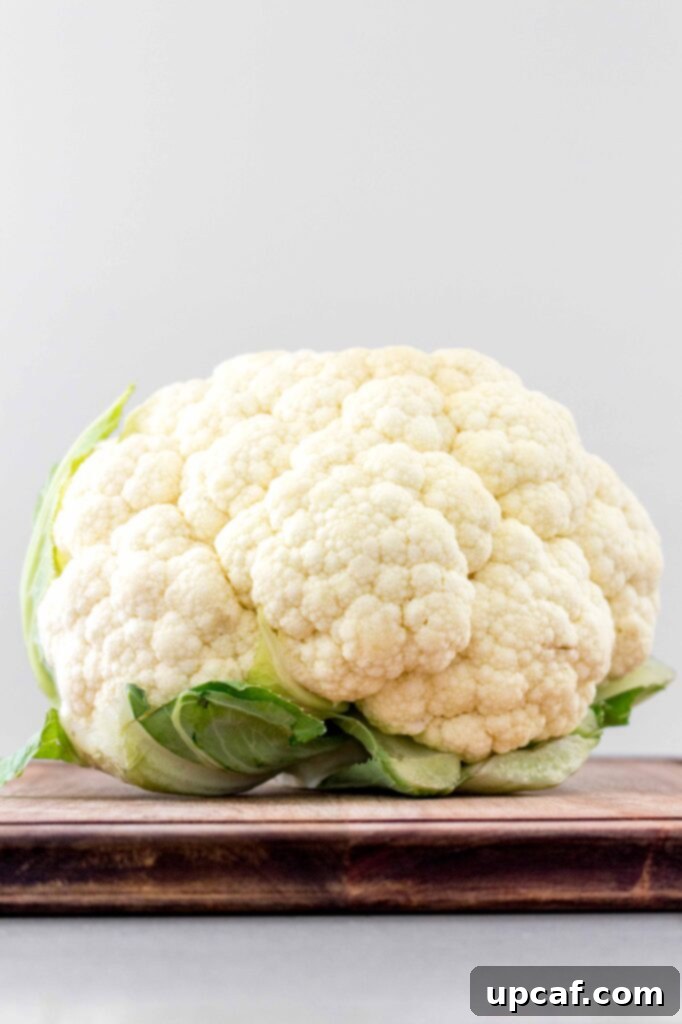
Essential Tools for Cutting Cauliflower
Before we dive into the technique, let’s ensure you have the right tools at hand. A well-equipped kitchen makes the task not only easier but also safer. You’ll primarily need:
- Sharp Chef’s Knife: This is your most important tool. A sharp chef’s knife (8-inch or 10-inch) will glide through the tough stem and florets effortlessly, reducing the risk of slipping and making cleaner cuts. A dull knife, conversely, can lead to more effort, frustrating results, and a higher chance of injury.
- Sturdy Cutting Board: Choose a large, stable cutting board that won’t slide around on your counter. Placing a damp paper towel or a non-slip mat underneath can add extra stability.
- Waste Bowl: Keep a bowl next to your cutting board to collect the discarded leaves and core. This helps keep your workspace tidy and makes cleanup a breeze.
Having these tools ready will streamline your cauliflower prep, allowing you to focus on the technique and enjoy the process.
How To Cut Cauliflower into Florets: A Step-by-Step Guide for Minimal Mess
Cutting a whole head of cauliflower into perfect florets might seem daunting at first, but with the right technique, it becomes a quick and mess-free task. Forget the scattered crumbs and uneven pieces; this method ensures beautifully uniform florets ready for any recipe. Follow these steps for an efficient and tidy prep:
- Step 1: Prepare Your Cauliflower
Start by placing the cauliflower stem-side down on your cutting board. This position provides maximum stability, preventing the head from rolling or wobbling as you begin to cut. It also exposes the stem and outer leaves, making them easier to remove.
Carefully remove the outer green leaves from the base of the cauliflower. You can either snap them off with your hands or use your knife to trim them away close to the stem. Don’t discard these leaves just yet; they are edible and can be used in various dishes (more on that later!).
- Step 2: Halve the Head
With the cauliflower still stem-side down, take your sharp chef’s knife and carefully slice the entire head in half. Begin at the very top of the cauliflower crown and cut straight down through the center, all the way to the core and through the stem. You should now have two symmetrical halves.
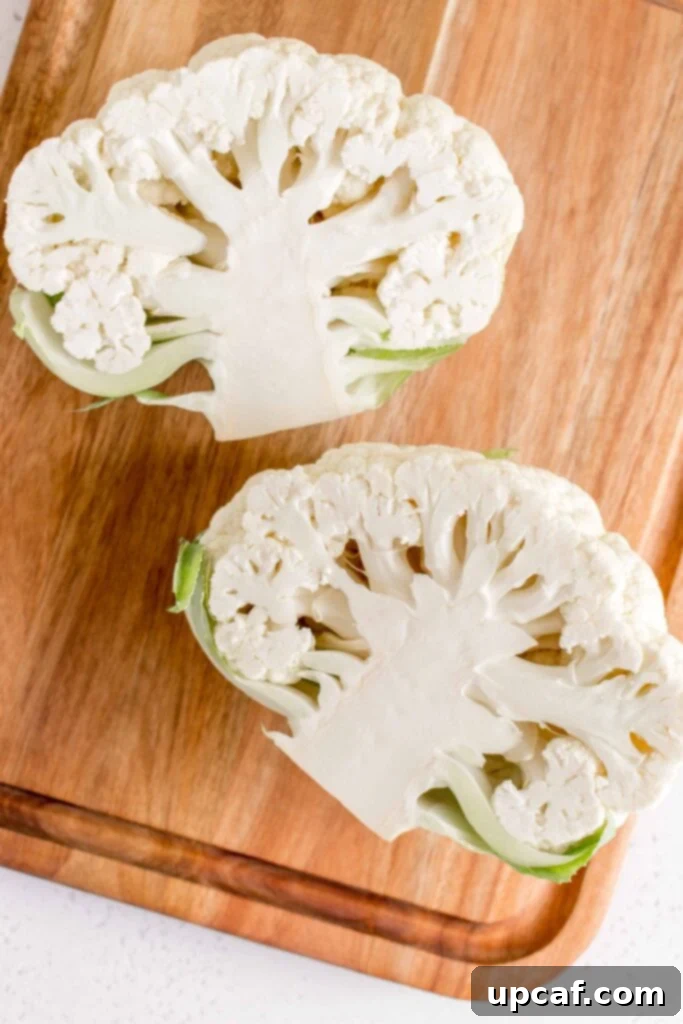
- Step 3: Remove the Core (The V-Cut Method)
Working with one half at a time, place it cut-side down on your board. Identify the firm, fibrous core at the center. To remove it efficiently and with minimal loss of florets, angle your knife to make two diagonal cuts, forming a “V” shape around the core. This technique allows you to cleanly detach the core from the florets with ease.
Repeat this V-cut process for the other half of the cauliflower. The goal is to free the florets from their central attachment point.
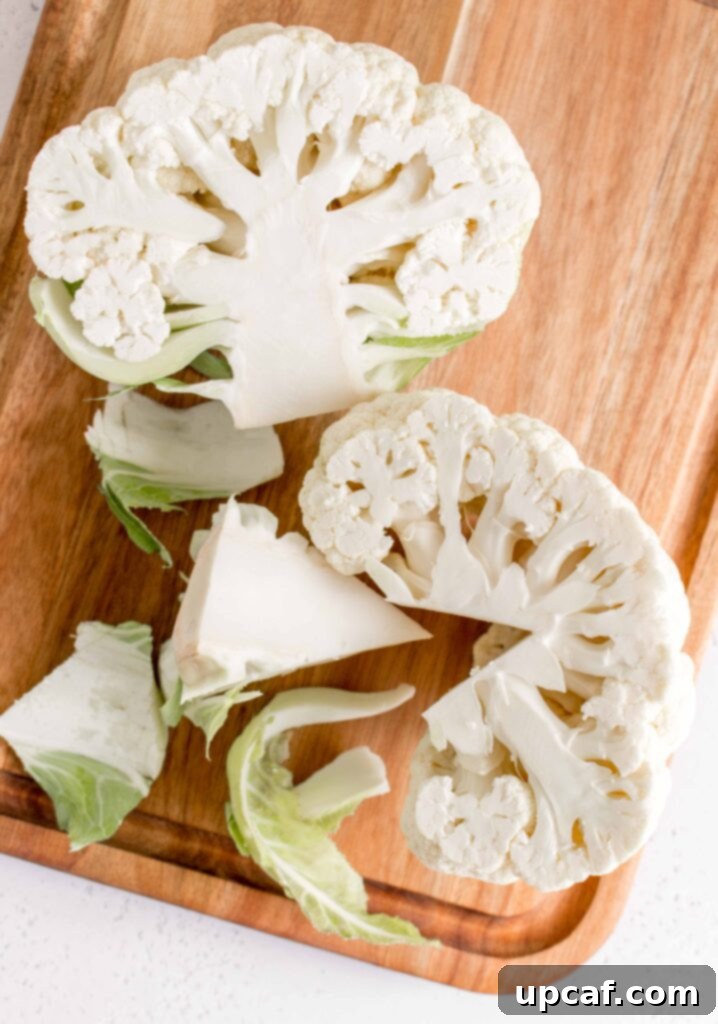
- Step 4: Separate the Florets
Once the core is removed from both halves, many florets will naturally begin to separate. To complete the process, use your hands to gently pull apart the cauliflower into individual florets. This manual separation is often the best way to get clean breaks and minimize those tiny crumbs that can make cleanup a chore. The natural breaking points of the cauliflower will guide you.
For any stubborn florets that remain attached or are too large, you can use your knife to carefully cut them away from the remaining stem sections.

- Step 5: Size Them Up (or Down!)
Now that you have separated florets, you might find some are too large for your intended recipe. If you wish, you can further cut larger florets into halves or quarters to achieve a more uniform size. Aim for florets that are roughly bite-sized to ensure even cooking, whether you’re roasting, steaming, or stir-frying.
Pro Tip: For different culinary uses, consider storing larger florets separately from smaller ones. Larger florets are great for roasting or grilling, while smaller ones are perfect for quick sautés, soups, or salads.

With these steps, you’ll master the art of cutting cauliflower, ensuring perfectly prepared florets every time with minimal fuss!
How To Store Cauliflower for Maximum Freshness
Proper storage is essential to extend the life of your cauliflower, whether it’s a whole head or freshly cut florets. Incorrect storage can lead to rapid spoilage, discoloration, and a loss of flavor.
How to Store a Full Head of Cauliflower from the Store:
When you bring home a whole head of cauliflower, it’s often wrapped tightly in plastic. While this protects it initially, it can trap moisture and accelerate spoilage over time. For optimal freshness, I recommend you replace this tight plastic packaging. Instead, wrap the head loosely with a few sheets of paper towels. The paper towels will absorb any excess moisture, preventing mold and keeping the cauliflower dry. Then, place the wrapped head in the vegetable crisper drawer of your refrigerator. Stored this way, a whole head of cauliflower can remain fresh for up to a week, or sometimes even longer.
How to Store Cut Cauliflower Florets:
Once you’ve cut your cauliflower into florets, their shelf life is slightly reduced due to increased exposure to air. To keep them fresh and crisp, store the cut florets in an airtight container or a sealed plastic bag (like a resealable freezer bag) in the refrigerator. Ensure there’s minimal air inside the container or bag to prevent oxidation. Stored correctly, your cauliflower florets will stay fresh and ready to use for up to 5-7 days.
Can You Freeze Cauliflower? Absolutely!
Freezing cauliflower is an excellent way to preserve its freshness and extend its usability for several months. This is particularly useful when cauliflower is in season and you want to stock up, or if you simply have more than you can use immediately. While you can freeze raw florets, a quick blanching step beforehand helps maintain its texture, color, and nutritional value when thawed.
- Blanching (Optional but Recommended): Bring a large pot of water to a rolling boil. Prepare an ice bath in a separate large bowl. Submerge your cauliflower florets in the boiling water for about 3 minutes. Immediately transfer them with a slotted spoon to the ice bath to stop the cooking process. Drain well and pat them thoroughly dry. Blanching helps to kill enzymes that can cause deterioration in flavor and texture during freezing.
- Single-Layer Freeze: Once your florets are completely dry (this is crucial to prevent ice crystals and clumping), spread them out in a single layer on a baking sheet or tray. Place the tray in the freezer for 1-2 hours, or until the florets are completely solid. This “flash freezing” step prevents the florets from sticking together in a large frozen block, making it easy to grab just the amount you need later.
- Transfer to Storage: After the florets are flash-frozen, transfer them into a freezer-friendly airtight plastic bag (like a heavy-duty ziploc bag) or a rigid freezer container. Squeeze out as much air as possible from bags to prevent freezer burn.
Properly frozen cauliflower florets can be stored in the freezer for up to 3-4 months. When ready to use, you can often add them directly to recipes like stir-fries, soups, or roasted dishes without thawing, though thawing overnight in the fridge is an option for more delicate preparations. Freezing is a fantastic way to enjoy cauliflower’s benefits year-round!
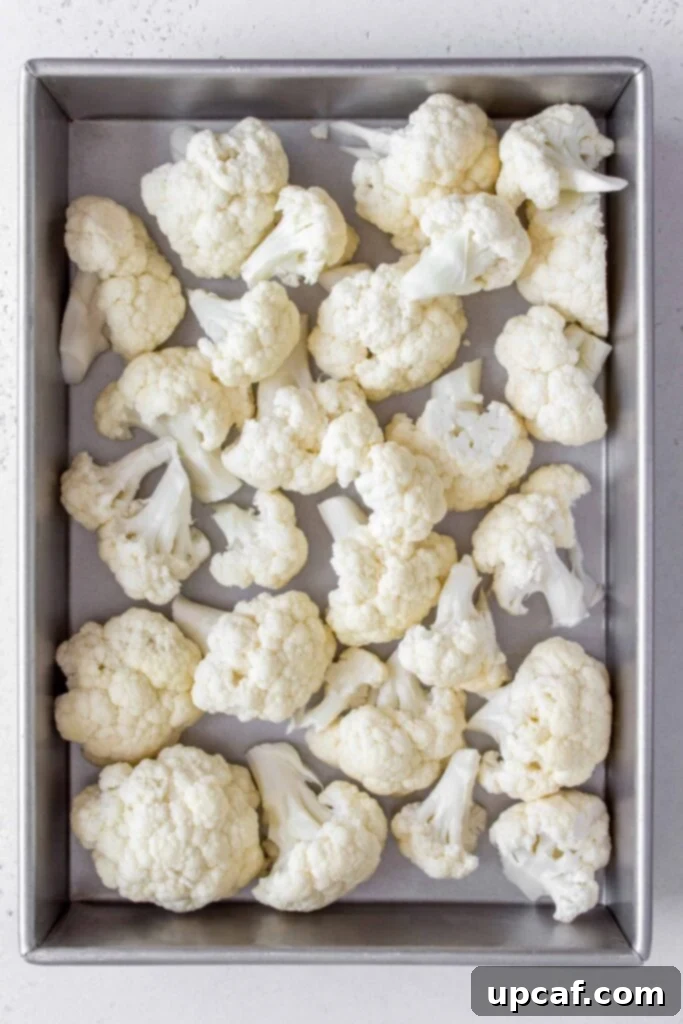
Best Knife to Cut Cauliflower
As previously mentioned, a sharp chef’s knife is undeniably the best tool for cutting a whole head of cauliflower. Its robust blade and ergonomic handle provide the leverage and precision needed to tackle the dense vegetable. The length of a chef’s knife (typically 8-10 inches) allows for long, clean cuts through the tough core and stem, reducing the need for multiple, awkward passes. A sharp edge is not just about efficiency; it’s also a significant safety measure, as it requires less force and is less likely to slip compared to a dull blade. Always ensure your knife is well-maintained and sharpened before beginning your cauliflower preparation.
When Is Cauliflower In Season (and the Cheapest!)
Knowing the peak season for cauliflower can help you find the freshest and most affordable heads. While cauliflower is generally available year-round in most supermarkets, its peak season typically runs from fall to early winter, roughly around September to November. During these months, you’re more likely to find cauliflower at its absolute best – crisp, flavorful, and often at its lowest price due to abundant harvests. Buying in season not only saves you money but also ensures you’re enjoying the vegetable when its quality is at its peak. Keep an eye out for sales and farmer’s market availability during these months to maximize your savings and freshness.
How To Deal With Brown Spots on Cauliflower
It’s not uncommon to find small brown or slightly discolored spots on cauliflower florets, even on otherwise fresh heads. These spots are usually a result of oxidation or minor bruising and are generally harmless. They don’t indicate spoilage unless they are soft, mushy, or accompanied by an unpleasant odor. If you encounter such spots on your cauliflower:
The simplest and most effective way to deal with them is to use a microplane grater or a small paring knife. Gently shave or cut off the discolored area. The cauliflower underneath should be perfectly fine and edible. There’s no need to discard the entire floret or head for a few superficial brown spots. This quick fix helps maintain the aesthetic appeal of your dish without wasting good produce.
Can You Eat Cauliflower Leaves and Stem? Absolutely! Embrace Zero-Waste Cooking
One of the wonderful aspects of cauliflower is its versatility, extending beyond just the florets. Both the leaves and the inner stem are completely edible and packed with nutrients, making them a fantastic component of zero-waste cooking. Many people unknowingly discard these parts, missing out on their unique flavor and health benefits.
- Cauliflower Leaves: The outer green leaves of cauliflower are often discarded, but they are delicious and nutrient-rich. They have a slightly bitter, peppery flavor similar to kale or collard greens. You can sauté them with garlic and olive oil for a simple side dish, roast them until crispy, or chop them finely and add them to stir-fries, soups, or stews for an extra layer of flavor and texture.
- Cauliflower Stem: The inner stem, once the fibrous outer layer is peeled, is tender and sweet, reminiscent of the florets themselves but with a slightly firmer texture. You may want to peel the very outside of the cauliflower stem as it can be tough. Once peeled, the inner part can be sliced or diced and added to the same dishes as the florets. It’s excellent when roasted, added to vegetable stocks, or blended into creamy purees and soups, adding thickness and flavor.
By utilizing the leaves and stem, you not only reduce food waste but also add more nutrition and flavor to your meals. It’s a testament to the fact that nearly every part of this incredible vegetable can be enjoyed!
Versatile Ways to Use Cauliflower in Your Kitchen
Cauliflower is a culinary chameleon, capable of transforming into an incredible array of dishes, from hearty mains to light sides. Its mild flavor and adaptable texture make it a staple for healthy and delicious cooking. Here are even more ways to enjoy your perfectly cut cauliflower florets:
- Blend it into a Smoothie: For a nutrient boost without altering the flavor, add a few raw or steamed florets to your morning smoothie. It adds creaminess and extra fiber.
- Turn it into a Soup: Roasted or boiled cauliflower makes a fantastic base for creamy, comforting soups. Blend it with broth and seasonings for a velvety smooth and surprisingly rich dish.
- Stir Fry It: Cauliflower florets absorb flavors beautifully, making them an excellent addition to any stir-fry. They add a satisfying crunch and hearty texture.
- Roast It: Roasting brings out cauliflower’s natural sweetness and nutty flavor. Toss florets with olive oil, salt, pepper, and your favorite spices, then roast until tender and caramelized.
- Turn it into Cauliflower Rice: A popular low-carb alternative, simply pulse raw florets in a food processor until they resemble rice grains. Sauté it with your favorite aromatics for a healthy side dish or base for curries.
- Steam It: Steaming is a gentle cooking method that preserves cauliflower’s nutrients and maintains a tender-crisp texture. It’s perfect for a quick and healthy side.
- Boil It: While often overlooked, boiling cauliflower until tender can be a great starting point for mashed cauliflower or for incorporating into gratins and casseroles.
- Mash It: Replace mashed potatoes with mashed cauliflower for a lighter, low-carb alternative. Boil or steam florets until very tender, then mash with butter, milk, and seasonings.
- Cauliflower Pizza Crust: For a gluten-free and vegetable-packed pizza base, use finely riced cauliflower mixed with egg and cheese to form a crust.
- Grilled Cauliflower Steaks: Cut thick slices of cauliflower (similar to steaks), marinate, and grill until tender and charred for a satisfying vegetarian main course.
The possibilities are truly endless with this versatile vegetable! Its mild taste allows it to take on almost any flavor profile you desire, making it a healthy and delicious addition to countless meals.
Delicious Recipes Using Cauliflower
Now that you’ve mastered the art of cutting cauliflower into perfectly sized florets and understand its myriad uses, it’s time to put those fresh pieces to good use! Cauliflower is incredibly versatile, lending itself to a wide range of flavorful dishes. Here are some fantastic recipes that will allow you to showcase your newfound knife skills and enjoy this amazing vegetable:
- Vegetarian Cauliflower Pita Wrap: A delightful and wholesome wrap packed with flavorful cauliflower and fresh ingredients, perfect for a light lunch or dinner.
- Buffalo Cauliflower Wings: A vegetarian twist on a classic favorite, these crispy and spicy cauliflower “wings” are a crowd-pleasing appetizer or snack.
- Cheesy Cauliflower Bread Sticks: A delicious, low-carb alternative to traditional breadsticks, these cheesy treats are perfect for dipping or as a savory side.
For more insightful cooking guides and kitchen tips, be sure to check out my guide on How To Cut a Watermelon, and many others available on the site.
I genuinely hope you find these tutorials helpful and enjoyable. Learning to efficiently prepare fresh ingredients like cauliflower can significantly enhance your cooking experience and make healthy eating more accessible. I encourage you to try these techniques, savor the results, and share your culinary adventures with your loved ones!
If you try this method and find it useful, please share your experience and creations with me on INSTAGRAM using my hashtag for a chance to be featured! Also, follow Cookin’ With Mima on FACEBOOK, INSTAGRAM, and PINTEREST for all my latest social posts, recipes, and helpful cooking tips.

How to Cut Cauliflower
Mariam Ezzeddine
5
5
4 servings
Ingredients
- 1 head cauliflower, or more
Instructions
- Place the cauliflower stem side down.
- Slice the cauliflower in half by starting at the top of the cauliflower crown down to the core.
- Cut the core out of each half of the cauliflower by angling your knife to cut a V shape into the core.
- Some florets will separate naturally but to help it along, use your hands and break apart the cauliflower into florets.
- If you wish, you can cut larger florets into halves or quarters. Or you can store larger florets together and smaller florets together for different uses.
Nutrition
Calories: 36kcal
|
Carbohydrates: 7g
|
Protein: 3g
|
Fat: 0.4g
|
Saturated Fat: 0.2g
|
Polyunsaturated Fat: 0.04g
|
Monounsaturated Fat: 0.1g
|
Sodium: 43mg
|
Potassium: 430mg
|
Fiber: 3g
|
Sugar: 3g
|
Vitamin C: 69mg
|
Calcium: 32mg
|
Iron: 1mg
Like this recipe? Rate and comment below!
